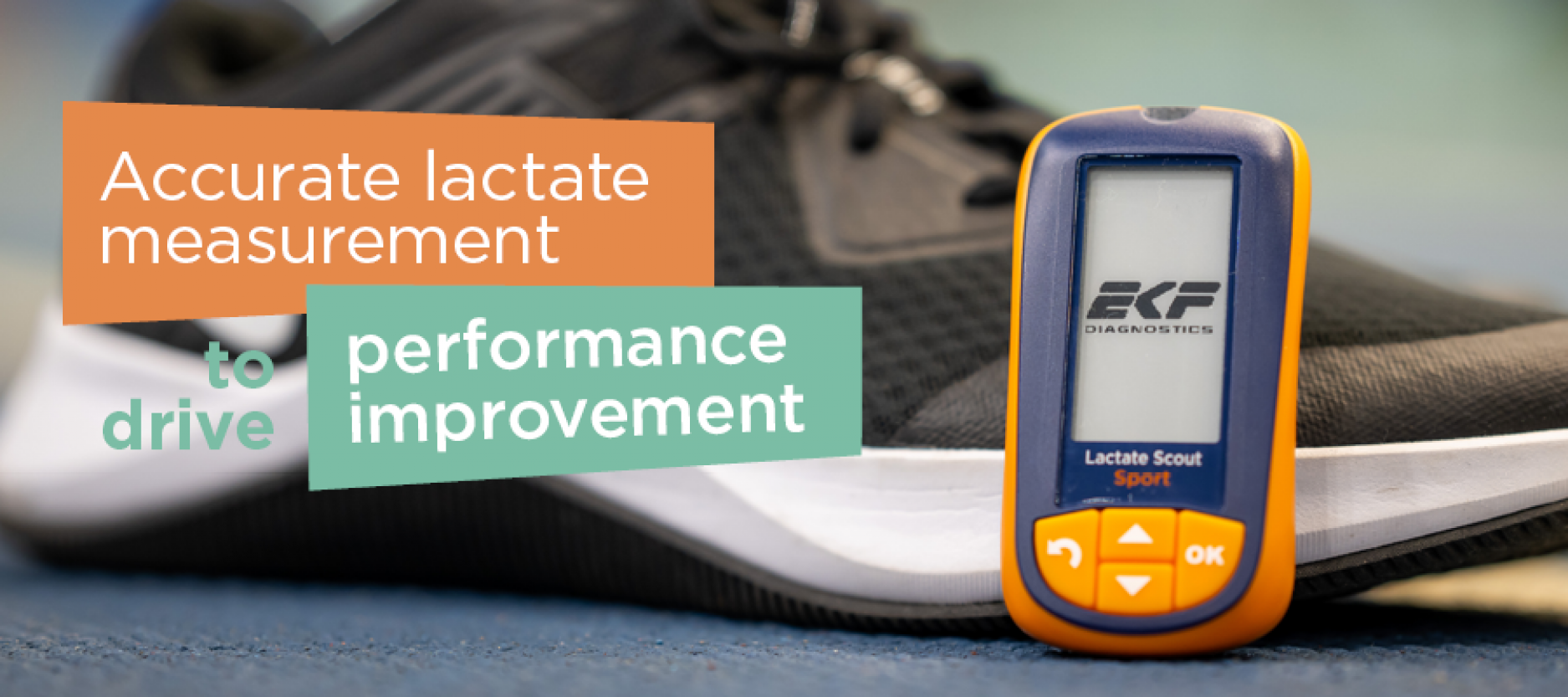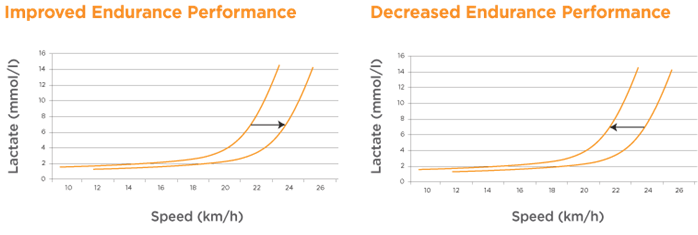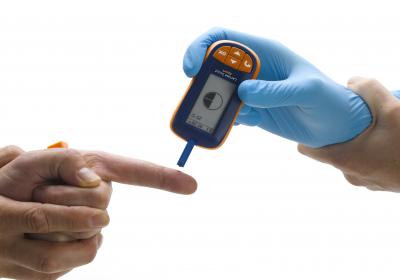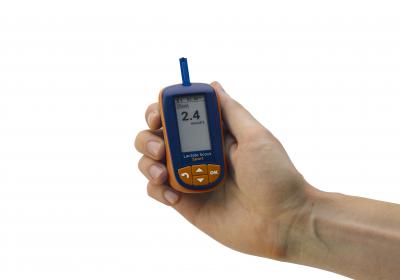
Lactate Scout Sport is the number one choice for sports scientists and professional athletes globally. The Lactate Scout Sport is a simple and reliable lactate meter perfect for training outdoors, in the gym or for analysing performance in a laboratory.
The Lactate Scout Sport is designed for field and gym use and is ideal for both coaches and athletes to rapidly measure lactate levels. From this measurement it is possible to assess athlete endurance levels, devise optimum training programmes, avoid over-training and to use metabolic information to help set target heart rate zones.
The lactate strips require only 0.2 µl of capillary blood and provides results in 10 seconds. Lactate Scout Sport can store up to 500 results and also connects with Bluetooth® enabled heart rate monitors. It also features a stopwatch function to help analyse performance.
With an integrated step test function and Bluetooth® connectivity, the Lactate Scout Sport is one of the most advanced hand-held lactate analysers on the market.
The Lactate Scout Sport is a user-friendly tool. The e-paper display is easy to navigate and provides excellent readability in varying light conditions and at different viewing angles.
During high-intensity exercise, the body produces lactate faster than it can be metabolised and removed from the blood stream. This leads to accumulation of lactate in the bloodstream.
Up to a certain threshold, the body can clear lactate at a rate at which, although there is an elevated concentration of lactate in the blood, the concentration does not impede muscle function.
Higher intensity exercise will lead to this threshold being passed, such that lactate production exceeds lactate clearance. The biochemical processes associated with increased lactate places muscle cells under stress. It is therefore important to determine the lactate threshold at which training is most effective.
A lactate analyser is therefore useful in fitness training and cardiovascular training, to help increase endurance without overtraining.
Lactate is a source of energy and is metabolised by muscle cells. The more efficiently lactate is metabolised the lower the blood lactate concentration will be during exercise. Additionally, excess lactate will be cleared from the circulation more rapidly during the post-exercise period.
Lac [blood] = Lac [produced] Lac [eliminated]
Endurance athletes should aim to achieve an elevated lactate equilibrium - a balance between the production and breakdown of lactate.
For training to achieve positive results and improve performance, it is therefore recommended to exercise at just below the anaerobic threshold.
Exercising at higher-intensity levels will result in exceeding the anaerobic threshold and cause a rapid increase in blood lactate concentration. This threshold varies from person to person, and an individual's threshold can be determined using a step test. In a step test, the intensity of training gradually increases at defined intervals, e.g. on a treadmill or exercise bike or in a field test. The blood lactate concentration is measured at the end of each interval and plotted against the load value on a chart. The resulting curve indicates the threshold value. The greater the intensity of the athlete’s exercise at their anaerobic threshold indicates a fitter athlete.
 If a training programme is designed so that exercise occurs in the anaerobic threshold range, it can have a positive impact on the metabolism, increase muscle cell contractions, improve muscle cell repair, increase blood capillaries and improve cardiac function. The body then produces energy more efficiently, even when exercising at higher levels of intensity.
If a training programme is designed so that exercise occurs in the anaerobic threshold range, it can have a positive impact on the metabolism, increase muscle cell contractions, improve muscle cell repair, increase blood capillaries and improve cardiac function. The body then produces energy more efficiently, even when exercising at higher levels of intensity.
During high-intensity exercise, the body produces lactate faster than it can be metabolised and removed from the blood stream. This leads to accumulation of lactate in the bloodstream.
Read more about lactate measurement for athletes.



There’s an updated hard carry case available for the Lactate Scout Sport.
The case features a hard plastic outer shell with two securing clasps and the Lactate Scout logo. The inside of the case contains a foam liner with cut out to securely hold your Lactate Scout Sport, the water spray bottle and up to three cannisters of strips. There’s also space for other accessories you may need when using your Lactate Scout.
Once the blood sample has been inserted, results are reported within 10 seconds.
Just 0.2 μl is required from a sample taken from a finger or earlobe.
The Scout measurement system operates on the basis of enzymatic-amperometrical detection.
This means that the device reads the electrical signal created by the reaction of the sample with the biochemical reagent on the inserted strip. This signal corresponds directly to the lactate concentration of the sample.
The Scout uses disposable ‘Sip In’ strips which automatically take up the precise required sample volume. The strip must be inserted into the device before the sample is taken because the biochemical reaction starts as soon as the blood comes into contact with the strip allowing the reading to be taken immediately. It is not possible to get readings from pre-filled or used strips.
The ‘Sip-In’ strips are designed specifically for human whole blood. Different samples, such as centrifuged blood / serum, chemical liquids and buffer solutions have different characteristics in their viscosity and biochemical content. For this reason, strips react much more sensitively to interferences in such samples.
After sampling whole blood changes its characteristics within seconds, so immediate sampling with fresh blood is highly recommended. Remains of disinfectant liquids, blood circulation-stimulating crèmes, dried blood and sweat must be always removed with clean water from the sampling area before taking the sample.
Sample quality plays a very important role in the accuracy of the result. To minimise external influences we recommend that the same sampling area is used throughout (finger tip or ear lobe). Different parts of the body provide different results because of differences in blood circulation.
2 CR2450 batteries will perform approximately 1,000 tests. Data storage and settings will not be lost when batteries are replaced.
Avoid storing the strips in direct sunlight or at high temperatures for long periods. For long term storage the strips should be kept in the closed vial in the refrigerator at -18°C to +8°C. The strips must be removed from the refrigerator 20 minutes before use so that they attain the same temperature as the device. The reagent is very sensitive to sunlight and humidity. It is recommended to only take the required number of strips from the vial for immediate use. After first opening the vial of strips, the storage stability is three months or until expiry date if it is sooner. Afterwards, inaccurate measurement results can occur. Strips can be kept at ≤25 °C for max. 30 days in the closed vial.
Always transport the device and strips in suitable conditions. Protect them from direct sunlight.
Strips are pre-calibrated. In order to synchronise the strips with the device a two-character calibration code (printed on the vial label) must be entered in the device when prompted. After 25 measurements the device reminds you to check the code settings with the used strip vial for confirmation or correction.
Wrong code settings may cause incorrect results, (depending on lactate concentration >+/- 1 mmol/L).
If there is no user activity during two minutes, the device automatically switches to stand-by mode. If no strip is inserted for more than two minutes the Scout switches off. To reactivate the device, simply press the OK button.
The integrated Bluetooth® Low Energy technology provides an easy way to send data to your PC and connect to heart rate monitors. EKF offers software solutions for fast and intelligent data analysis, suitable for all levels of athlete.
Due to the high number of potential interferences in lactate measurement and the specific characteristics of different analysers no standard measurement has been defined. The characteristics and trends of lactate curves (given from step tests) are much more meaningful than a comparison of single/absolute values.
The Lactate Scout Sport compensates for the influence of low (20 - <35%) and high (>50 - 70%) hematocrit levels on the lactate reading. This leads to a significantly increased accuracy in these ranges. Studies have shown that the precision depends on the lactate concentration.
Hct range 35 - 50%:
At blood lactate concentration 0.5 - 6.7 mmol/L standard deviation is ≤0.2 mmol/L; at 6.8 - 25 mmol/L CV is ≤3% (95% of measurements).
Hct range 20 - <35%; >50 - 70%:
At blood lactate concentration 0.5 - 7.5 mmol/L standard deviation is ≤0.3 mmol/L, at 7.6 - 25 mmol/L CV is ≤4% (95% of measurements).
The Lactate Scout Sport is calibrated to whole blood. Therefore, measurement results obtained with the Lactate Scout Sport cannot be compared to results of plasma-calibrated laboratory tests. The Lactate Scout Sport shows a good correlation with EKF Diagnostic’s whole blood-calibrated lactate analyzer, Biosen.
Lactate Scout Sport operates in a temperature range of 10 - 45°C. There is an internal temperature sensor in the Scout and a warning symbol will flash if the sensor detects temperatures that are too high or too low. The device and the strip must reach the same temperature.
Sweat contamination can deliver significantly higher values of lactate at rest or levels of moderate effort. Sweat should only be removed with water. Cleaning with alcohol swabs is insufficient and may even dilute the blood sample. After cleaning, the puncture area must be dried. A water spray bottle can be purchased seperately.
High resting values may also be caused by general stress, metabolic or health problems or even by diet. Usually, the values will come to a ‘normal’ level (about 2 mmol/L) during the first training steps. If the values remain high or significantly increased the step test should be aborted and a medical check of the user should be undertaken.
Copyright © 2024 | Powered by Intergage

Please note: Not all products are available in all countries. Please check availability.
Newsletter
Keep up to date with all our activities, events, exhibitions, promotions, investor news & more.